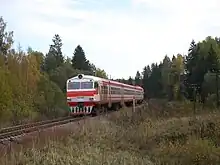Riga–Lugaži Railway
The Riga–Lugaži Railway is a 166 kilometres (103 mi) long,[2] 1,524 mm (5 ft) gauge railway in Latvia. It was built in the late 19th century (commencing in 1886) to connect the cities of Riga and Saint Petersburg via Valga and Pskov. The railway was opened in 1889.[1]
| Riga–Lugaži Railway | |
|---|---|
| Overview | |
| Termini |
|
| Service | |
| Operator(s) | Latvian Railways |
| History | |
| Opened | 1889[1] |
| Technical | |
| Line length | 166 km (103.15 mi)[2] |
| Track gauge | 1,524 mm (5 ft) |
Riga-Lugaži line | ||||||||||||||||||||||||||||||||||||||||||||||||||||||||||||||||||||||||||||||||||||||||||||||||||||||||||||||||||||||||||||||||||||||||||||||||||||||||||||||||||||||||||||||||||||||||||||||||||||||||||||||||||||||||||||||||||||||||||||||||||||||||||||||||||||||||||||||||||||||||||||||||||||||||||||||||||||||||||||||||||||||||||||||||||||||||||||||||||||||||||||||||||||||||||||||||||||||||||||||||||||||||||||||||||||||||||||||||||||||||||||||||||||||||||||||||||||||||||||||||||||||||||||||||||||||||||||||||||||||||||||||||||||||||||
|---|---|---|---|---|---|---|---|---|---|---|---|---|---|---|---|---|---|---|---|---|---|---|---|---|---|---|---|---|---|---|---|---|---|---|---|---|---|---|---|---|---|---|---|---|---|---|---|---|---|---|---|---|---|---|---|---|---|---|---|---|---|---|---|---|---|---|---|---|---|---|---|---|---|---|---|---|---|---|---|---|---|---|---|---|---|---|---|---|---|---|---|---|---|---|---|---|---|---|---|---|---|---|---|---|---|---|---|---|---|---|---|---|---|---|---|---|---|---|---|---|---|---|---|---|---|---|---|---|---|---|---|---|---|---|---|---|---|---|---|---|---|---|---|---|---|---|---|---|---|---|---|---|---|---|---|---|---|---|---|---|---|---|---|---|---|---|---|---|---|---|---|---|---|---|---|---|---|---|---|---|---|---|---|---|---|---|---|---|---|---|---|---|---|---|---|---|---|---|---|---|---|---|---|---|---|---|---|---|---|---|---|---|---|---|---|---|---|---|---|---|---|---|---|---|---|---|---|---|---|---|---|---|---|---|---|---|---|---|---|---|---|---|---|---|---|---|---|---|---|---|---|---|---|---|---|---|---|---|---|---|---|---|---|---|---|---|---|---|---|---|---|---|---|---|---|---|---|---|---|---|---|---|---|---|---|---|---|---|---|---|---|---|---|---|---|---|---|---|---|---|---|---|---|---|---|---|---|---|---|---|---|---|---|---|---|---|---|---|---|---|---|---|---|---|---|---|---|---|---|---|---|---|---|---|---|---|---|---|---|---|---|---|---|---|---|---|---|---|---|---|---|---|---|---|---|---|---|---|---|---|---|---|---|---|---|---|---|---|---|---|---|---|---|---|---|---|---|---|---|---|---|---|---|---|---|---|---|---|---|---|---|---|---|---|---|---|---|---|---|---|---|---|---|---|---|---|---|---|---|---|---|---|---|---|---|---|---|---|---|---|---|---|---|---|---|---|---|---|---|---|---|---|---|---|---|---|---|---|---|---|---|---|---|---|---|---|---|---|---|---|---|---|---|---|---|---|---|---|---|---|---|---|---|---|---|---|---|---|---|---|---|---|---|---|---|---|---|---|---|---|---|---|---|---|---|---|---|---|---|---|---|---|---|---|---|---|---|---|---|---|---|---|---|---|---|---|---|---|---|---|---|---|---|---|---|---|---|---|---|---|---|---|---|---|---|---|---|---|---|---|---|---|---|---|---|---|---|---|
| ||||||||||||||||||||||||||||||||||||||||||||||||||||||||||||||||||||||||||||||||||||||||||||||||||||||||||||||||||||||||||||||||||||||||||||||||||||||||||||||||||||||||||||||||||||||||||||||||||||||||||||||||||||||||||||||||||||||||||||||||||||||||||||||||||||||||||||||||||||||||||||||||||||||||||||||||||||||||||||||||||||||||||||||||||||||||||||||||||||||||||||||||||||||||||||||||||||||||||||||||||||||||||||||||||||||||||||||||||||||||||||||||||||||||||||||||||||||||||||||||||||||||||||||||||||||||||||||||||||||||||||||||||||||||||

The final station in Latvia is Lugaži (near Valka). The railway was last used for the Riga–Saint Petersburg service in 1998, after which St Petersburg trains operated via Rēzekne. For several years there were no cross-border services, and trains terminated at Lugaži, but since 2008 a regular passenger service again operates from Riga to Valga in Estonia twice a day, with an onward connection to Tallinn via a train in Estonia. During the COVID-19 pandemic, the Riga-Lugaži railway cut services to Valga, with trains ending in Lugaži. Service was restored in May 2020.
Stations
| Station | Locale |
|---|---|
| Rīga (Connections to all lines) | Riga |
| Zemitāni (Connections to Skulte) | |
| Čiekurkalns | |
| Jugla | |
| Batlezers (Closed 2019) | Garkalne municipality |
| Garkalne | |
| Krievupe | |
| Vangaži | Inčukalns municipality |
| Inčukalns | |
| Egļupe | Sigulda municipality |
| Silciems (Closed 2019) | |
| Sigulda | |
| Līgatne | Līgatne municipality |
| Ieriķi | Amata municipality |
| Melturi | |
| Āraiši | |
| Cēsis | Cēsis municipality |
| Jāņmuiža | Priekuļi municipality |
| Lode | Rūjiena municipality |
| Bāle (Closed 2019) | Beverīna municipality |
| Valmiera | Valmiera municipality |
| Brenguļi (Closed 2019) | Beverīna municipality |
| Strenči | Strenči municipality |
| Seda (Closed 2019) | |
| Saule (Closed 2019) | Valka municipality |
| Lugaži | |
| Valga | Estonia |
References
- "Latvijas dzelzceļu līnijas" [Latvian railway lines] (in Latvian). Latvian Railway History Museum. Archived from the original on 2010-08-19. Retrieved 2010-10-09.
- "Publiskās lietošanas dzelzceļa infrastruktūras pārskats 2011" [2011 Public Railway Infrastructure Overview] (PDF) (in Latvian). Latvian Railways. 2010-06-05. p. 36. Archived from the original (PDF) on April 9, 2011. Retrieved 2010-10-09.